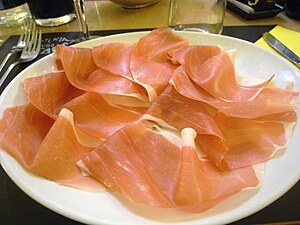Cookbook:Prosciutto
| Prosciutto | |
|---|---|
 | |
| Category | Meat and poultry |
Cookbook | Recipes | Ingredients | Equipment | Techniques | Cookbook Disambiguation Pages | Ingredients
Prosciutto is an Italian word for ham. In English, the term prosciutto is almost always used for a dry-cured ham that is usually sliced thinly and served uncooked; this style is called prosciutto crudo in Italian and is distinguished from cooked ham, prosciutto cotto.
Commonly associated with Tuscany and Emilia, the most renowned and expensive legs of prosciutto come from central and northern Italy, such as those of Parma, Friuli-Venezia Giulia, and San Daniele.
Manufacture
editThe process of making prosciutto can take anywhere from nine months to two years, depending on the size of the ham.
Writer on Italian food Bill Buford describes talking to an old Italian butcher who says:
"When I was young, there was one kind of prosciutto. It was made in the winter, by hand, and aged for two years. It was sweet when you smelled it. A profound perfume. Unmistakable. To age a prosciutto is a subtle business. If it's too warm, the aging process never begins. The meat spoils. If it's too dry, the meat is ruined. It needs to be damp but cool. The summer is too hot. In the winter—that's when you make salumi. Your prosciutto. Your soppressata. Your sausages.
Today, the ham is first cleaned, salted, and left for about two months. During this time the ham is pressed, gradually and carefully to avoid breaking the bone, to drain all blood left in the meat. Next it is washed several times to remove the salt and hung in a dark, well-ventilated environment. The surrounding air is important to the final quality of the ham; the best results are obtained in a cold climate. The ham is then left until dry. The amount of time this takes varies, depending on the local climate and size of the ham. When the ham is completely dry it is hung to air, either at room temperature or in a controlled environment, for up to eighteen months.
Use
editSliced prosciutto crudo in Italian cuisine is often served as an antipasto, wrapped around grissini or, especially in summer, cantaloupe or honeydew. It is eaten as accompaniment to cooked spring vegetables, such as asparagus or peas. It may be included in a simple pasta sauce made with cream, or a Tuscan dish of tagliatelle and vegetables. It is used in stuffings for other meats, such as veal, as a wrap around veal or steak, in a filled bread, or as a pizza topping.